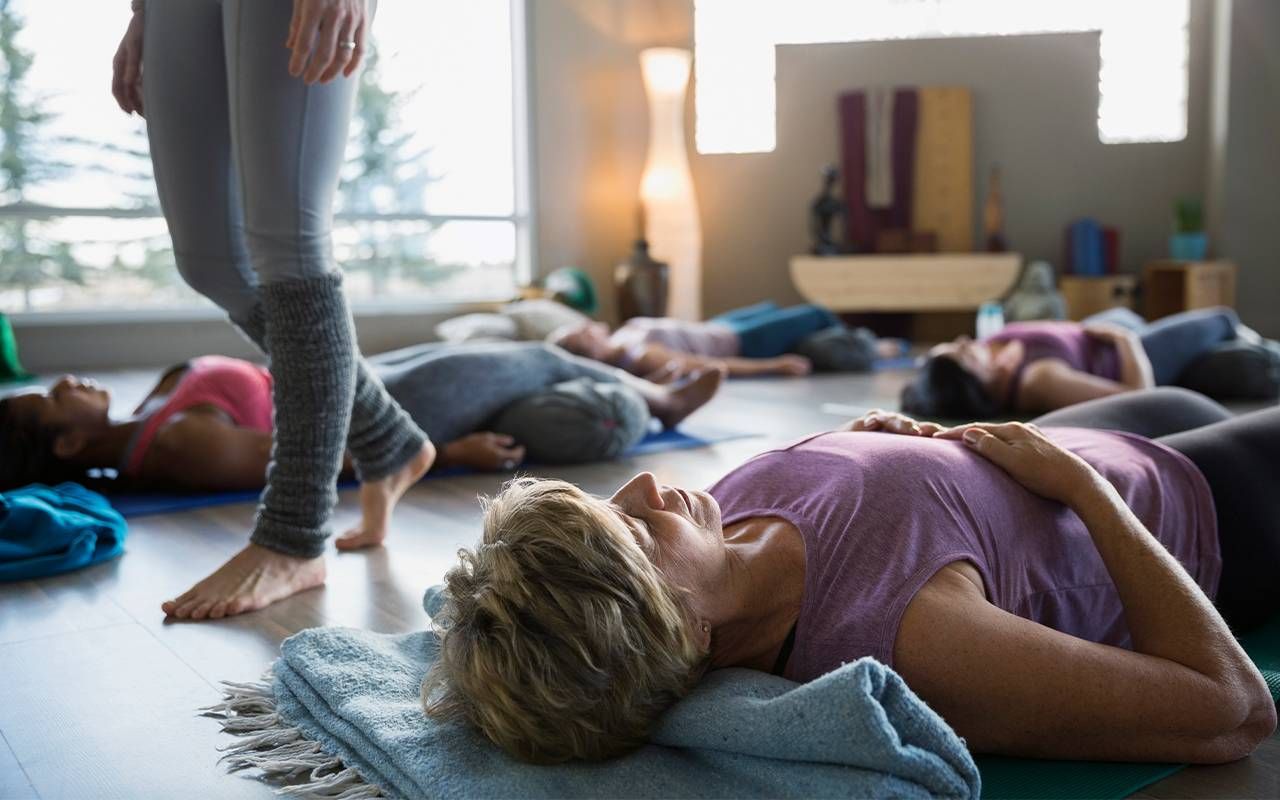Healing in Stillness
How understanding passive yoga can help you take a mindful pause
Passive yoga practices provide healing benefits accessible to more people than active yoga. But most people are unaware of these styles of yoga or disregard them because they seem easy, dull or unproductive.

In passive yoga, the body is at rest.
American culture believes benefits only come from active work; we MAKE things happen. We reward extreme efforts like Iron Man marathons. And in contrast, being still seems lazy and unbeneficial. But we need balance in our lives.
Yoga philosophy understands the need for healthy balance and offers both active and passive styles of yoga. Active yoga, the most popular in the United States, involves bodies flowing from one pose to another, rarely holding a pose for more than 30 seconds.
The poses require strength, balance and flexibility, which build heat in the body like other forms of exercise. The mind focuses on the breath, the position of the limbs, and the activation of muscles to ensure correct and safe poses.
Time to Be Still
In passive yoga, the body is at rest. Practitioners sit or lie down on the floor, using bolsters, blankets, pillows and blocks to support the body and fill the space between the body and the floor.
The support allows muscles to relax completely and gives the practitioner time to sink into stillness. Practitioners stay in poses for one to five minutes, sometimes more.
Because practitioners are still, there isn't much heat built up in the body. Often practitioners will use blankets to keep themselves warm. The relaxation and stillness create more profound healing for their physical, emotional and mental health.
Yin Yoga reduces stress and anxiety as it calms and balances the mind and body.
To many, the stillness sounds boring or pointless. But passive yoga creates healing beyond what any active exercise could provide. Furthermore, passive yoga improves performance everywhere: traditional exercise, work, relationships and overall health.
The three most common types of passive yoga are Yin, Restorative and Yoga Nidra. Here's what you need to know:
Yin Yoga
To understand Yin Yoga's name, we need to understand the idea of Yin and Yang. Yang represents all things in life that are active, bright, exposed and masculine. Yin represents the opposite; all the things in life that are passive, dark, hidden and feminine.
Yin Yoga's name comes from being the opposite of Yang or active yoga. Yin's goal is to bypass the muscles (Yin) to isolate and stretch the tendons and ligaments (Yang). The sensation of stretching connective tissue can be intense. It is essential to listen to your body, focus on relaxing and know your limits.
According to Bernie Clark, founder of YinYoga.com, "One of the big benefits of a Yin Yoga practice is precisely this ability to pay attention: in the yang forms of yoga, we are only in a posture for a short period – five breaths, or maybe a minute or so."
"In Yin Yoga we literally marinate in the juiciness of the pose, and pay attention to the flow of sensations. Yin Yoga gives us a chance to learn what sensations are, where they are, whether they are healthy, albeit challenging, or too much. We learn what an edge is, which is something that can be missed entirely in our yang practice."
"One of the benefits of a Yin Yoga practice is precisely this ability to pay attention."
"In the yang styles of yoga, especially for beginners, we are worried so much about all the details of the postures: the alignment, the muscular engagements, the teacher's directions, the breath, the bandhas (an energy "lock.") With Yin Yoga, we have time to learn how to pay attention to sensations, to our edge."
Along with body awareness, the physical benefits of Yin Yoga are lengthening the ligaments, tendons and fascia, which improves joint mobility and increases circulation. People who practice Yin Yoga report being able to sit or stand still in daily life for longer lengths of time without knee, hip or back pain.
Emotionally, Yin Yoga reduces stress and anxiety as it calms and balances the mind and body. But to Clark, "The greatest gift a teacher can give students is the ability to know their own body, their own heart, and their own mind and the ability to develop their own practice."
Clark offers virtual Yin Yoga classes on Sunday mornings and free videos on YouTube.
Restorative Yoga
Restorative yoga is often confused with Yin Yoga. However, the two practices are very different. As Clark describes it, "Restorative yoga is a form of practice directed toward students who are injured, stressed or ill, who need a very gentle practice and who are looking to regain the quality of life that they used to have, but have lost."
"It involves the use of props (sometimes lots of props) to allow the body to feel totally supported, to allow the body to relax and release; long holds of these gentle postures, postures often selected to address specific challenges; and deep mental and visceral relaxation."
People believe one hour of Yoga Nidra yields the same benefit as four hours of sleep.
"Restorative yoga takes an unhealthy body and brings it (hopefully) back to normal, while Yin Yoga takes a healthy body and brings it up to optimum."
Restorative yoga is precisely what the name implies, a practice of relaxation to restore health. It activates the parasympathetic nervous system, promoting emotional, physical and mental health, including detoxification and cellular regeneration.
In this practice, the idea is to support the body to remove all effort so the practitioner can focus on releasing all tension from the body. The goal is to feel no sensation. It is more challenging than it sounds. Relaxing into stillness takes patience and meditative focus. With practice, practitioners learn to melt into the experience quickly.
Restorative yoga classes are for anyone who can get up and down from the floor. Find a private restorative yoga teacher to help modify the poses if the floor is inaccessible. Many local and online yoga studios offer Restorative yoga classes. Many teachers provide free Restorative videos on YouTube.
Yoga Nidra
Yoga Nidra, translated as 'yogic sleep,' is an ancient form of guided meditation. The teacher guides the practitioner's awareness from the external world through the internal world by talking them through body awareness into images and experiences in their mind.
The goal is to bring the practitioner to the deep state of consciousness relaxation experienced between sleeping and waking. It is most commonly practiced lying supine to promote relaxation, but it can also be practiced lying face down or on your side. Yoga Nidra students report feeling half asleep, like the brain is dozing.
Jeremy Wolf, a renowned Yoga Nidra teacher, says, "At the deepest level of Yoga Nidra, awareness of the external world, one's body, and all of the mental stories that comprise one's sense of self is entirely absent. The mind becomes still and quiet as one rests in the silent space of awareness. Here one can recognize their essential nature as the very source of peace, limitless and free."
The practitioner's senses, intellect and mind relax in this state. The brain activity reduces, and the body goes into a healing state where the mind refreshes and removes baggage from the subconscious. People believe one hour of Yoga Nidra yields the same benefit as four hours of sleep.
As for the benefits, Wolf says, "There have been numerous studies on Yoga Nidra, and it is widely recognized as a very effective method for treating and even healing a variety of disorders including stress/anxiety, depression, PTSD/trauma, addiction, insomnia, and other psychosomatic disorders. It is quite common for practitioners to experience a sense of freedom, a refreshed perspective, and even a new relationship to life within just a few sessions."
Wolf offers a donation-based virtual Yoga Nidra session on Wednesday nights. And the free meditation app "Insight Timer" has many free Yoga Nidra sessions.
The Takeaway
Practicing passive yoga adds unique healing benefits unattainable in other, more active practices. Similarly, some styles, like Yoga Nidra, are accessible to everyone and often free. The rush and stress of everyday life prescribe the need for healing in stillness. Everyone can benefit from the deep healing of passive yoga.


